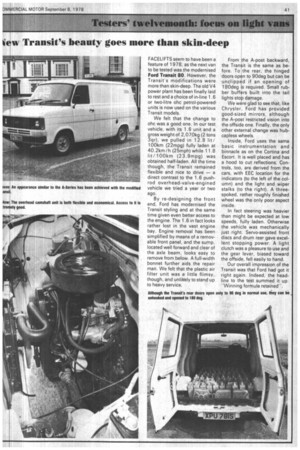w Transit's beauty goes more than skin-deep
Page 43

If you've noticed an error in this article please click here to report it so we can fix it.
FACELIFTS seem to have been a feature of 1978, as the next van to be tested was the modernised Ford Transit 80. However, the Transit's modifications were more than skin-deep. The old V4 power plant has been finally laid to rest and a choice of in-line 1.6 or two-litre ohc petrol-powered. units is now used on the various Transit models.
We felt that the change to ohc was a good one. In our test vehicle, with its 1.6 unit and a gross weight of 2,070kg (2 tons 3qr), we pulled in 12.8 lit/ 100km (22mpg) fully laden at 40.2km /h (25mph) while 11.8 lit/ 100km (23.9mpg) was obtained half-laden. All the time though, the Transit remained flexible and nice to drive — a direct contrast to the 1.6 pushrod overhead-valve-engined vehicle we tried a year or two ago.
By re-designing the front end, Ford has modernised the Transit styling and at the same time given even better access to the engine. The 1.6 in fact looks rather lost in the vast engine bay. Engine removal has been simplified by means of a removable front panel, and the sump, located well forward and clear of the axle beam, looks easy to remove from below. A full-width bonnet further aids the repair man. We felt that the plastic air filter unit was a little flimsy, though, and unlikely to stand up to heavy service. From the A-post backward, the Transit is the same as before. To the rear, the hinged doors open to 90deg but can be unclipped if an opening of 180deg is required. Small rubber buffers built into the tail lights stop damage.
We were glad to see that, like Chrysler, Ford has provided good-sized mirrors, although the A-post restricted vision into the offside one. Finally, the only other external change was hubcapless wheels.
Inside, Ford uses the same basic instrumentation and binnacle as on the Cortina and Escort. It is well placed and has a hood to cut reflections. Controls, too, are derived from the cars, with EEC location for the indicators (to the left of the column) and the light and wiper stalks (to the right). A threespoked, rather roughly finished wheel was the only poor aspect inside.
In fact steering was heavier than might be expected at low speeds, fully laden. Otherwise the vehicle was mechanically just right. Servo-assisted front discs and drum rear gave excellent stopping power. A light clutch was a pleasure to use and the gear lever, biased toward the offside, fell easily to hand.
Our overall impression of the Transit was that Ford had got it right again. Indeed, the headline to the test summed it up: "Winning formula retained-.
















































































































































